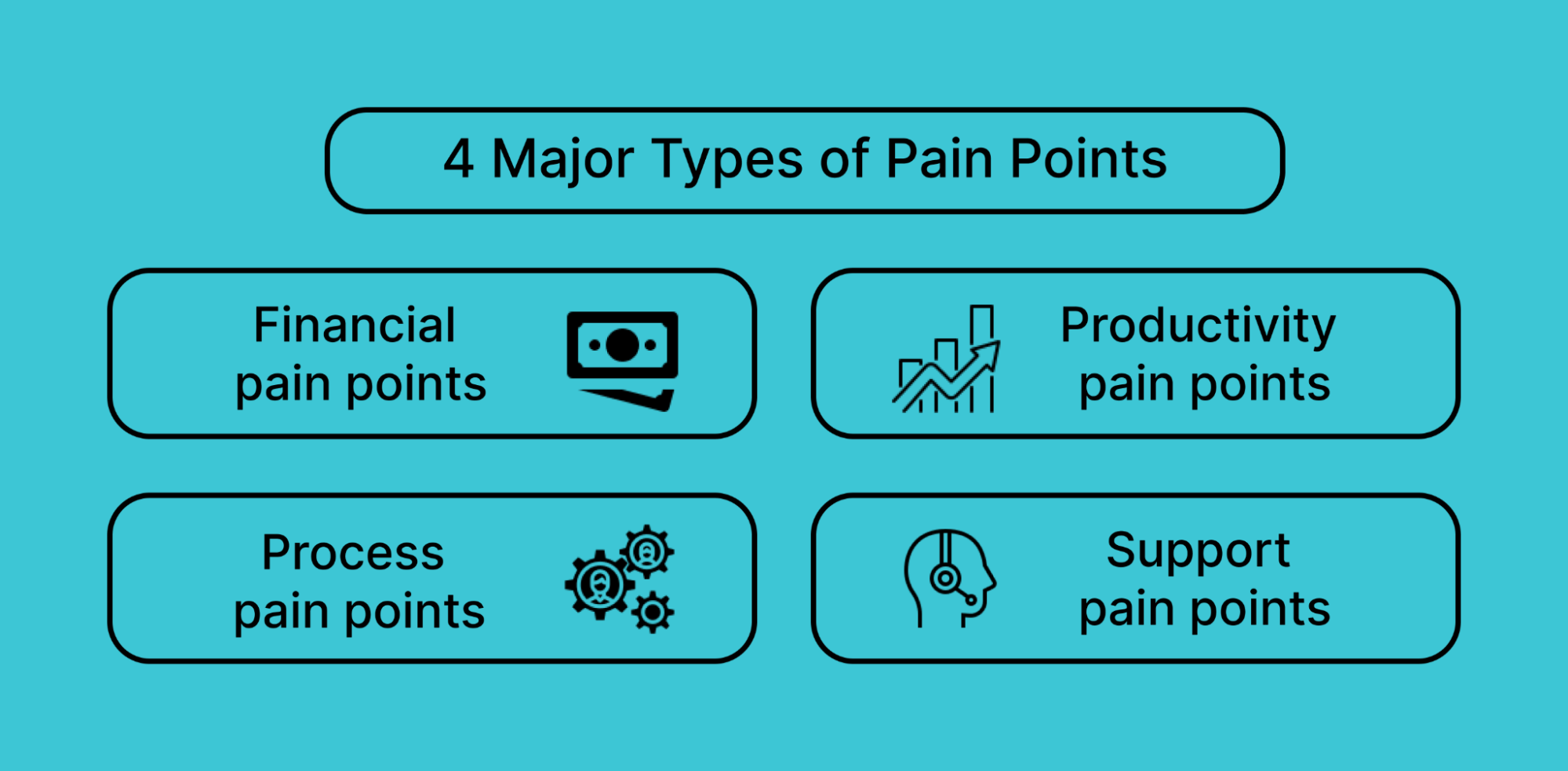The search for pain points usually starts before the business launch and comes up over and over again during marketing campaigns. They are also addressed when you decide on company improvements.
Businesses invest a lot of time and money to find pain points. And this investment always has a great return: you get more informed strategic decisions, more effective advertisement spending, and more sales.
Let’s define pain points and what kinds are out there. We have also prepared practical tips on how you can find pain points.
Content:
What are customer pain points?
Customer pain points are customers’ problems that they need to solve. Sometimes they need a new product to solve the problem. However, there are all kinds of products already, so more often than not, customers need to find a company that serves their needs better than others.
For example, one of the main customer pain points is that they hate waiting for products from abroad and want to try them in real life before buying. So you create a shop where you order things from several brands in advance or offer two-days-shipping with a flexible return policy.
Sometimes customers don’t understand their pain points yet, but you should. You can compare and see from the above what problems they face, especially while comparing the same product within different brands.
Common types of pain points
Depending on the business or product type, customers will face different pain points. You will have to dive deep and get into your customer’s shoes to know what their problem is exactly.
Yet, we can classify them to help you understand what to pay attention to, so you can later specify a unique pain point for your customers.

Financial pain points
Pricing does matter when it comes to making a purchase decision. However, not all customers will just take the lowest price and deal with it. Some are thinking long-term and, therefore, will pay attention to the following:
- product longevity: some are ready to invest a little bit more if they know that the product will serve them longer;
- the number of payments: if there is a possibility of a dispersed payment, people are more open to the idea of investing in a high-quality item;
- reusable/disposable: some are ready to invest once and use the product numerous times (especially if it is an environmentalist), and some prefer to buy cheap but one-time use products;
- bulk or single product: some like to buy more and pay more if they know that the bulk price is lower;
- lack of transparency about the final price: people hate to get additional fees at the checkout process or after receiving the delivery.
You will have to find the price solution based on what your customers like better or have an opportunity to buy.
Productivity pain points
The final goal is to help your customer be efficient. It depends on how you will provide this efficiency.
Sometimes it is about boosting the efficiency of your business so that customers can be more productive. For example, it is when you make the checkout process as fast as possible, promise free shipping, or prepare food of the highest possible quality.
Sometimes it is about boosting customers’ efficiency with a product. For example, you can automate their financial planning in sheets by introducing an app, or offer a self-updating contact book.
Process pain points
Process pain points are connected to awkward processes in your business that lower customer satisfaction and the quality of their experience. There can be many pain point examples; they are mostly related to:
- a bad-functioning website in terms of speed and navigation;
- limited payment and delivery options;
- no delivery tracking;
- no return policy.
Support pain points
Support pain points are also called people pain points sometimes. It is about person-to-person communication between a customer and a company.
Read our recent blog post to learn about the most common customer service challenges and discover actionable tips on how to solve them.
The most common issues with customer support are:
- long response waiting times;
- limited options of communication channels;
- not enough information on the products, payments, delivery, and returns.
How to identify customer pain points
It is not that straightforward when it comes to customer pain points. Your main task is to become a customer of yours to feel your business or product through their worldview. When you are in this business, it is almost impossible to do so because all the processes seem very logical and perfect.
So how do you get into your customers’ shoes and identify their pain points? Here are five effective ways.
Do qualitative market research
The simplest way to learn what your customers want is to ask them. However, when it comes to pain points, it should never be “rate from one to ten” or multiple-choice questions. Qualitative market research should be about open answers and personal experiences.
The best option is to sit down with people for a one-on-one interview. This is the best way to have a deep conversation with someone and guide a customer to share their pains and even discover new ones. You can have personal interviews via phone or hold a workshop where you can both define problems and let your customers give you advice on solutions.
You can also send out questionnaires and offer something in return since such qualitative surveys often take quite some time. However, the investment is worth it.
The typical questions for qualitative market research are the following:
- What are the problems you face while using our services or products?
- If you could change something about our company or product, what would it be?
- What kind of solution do you want to see for this pain point?
- What would you like to automate? What steps in your buying process take you too long or do you want to get rid of?
- We’ve found that X is a common source of pain for our customers. How do you feel about it?
Analyze your brand mentions on social media and forums
Customers often leave feedback on services and products used on social media or forums like Reddit and Quora. You can just run a search based on your brand name to see what people talk about you and detect issues that upset people. Using this approach, you can also find some ideas about how your customers wish to improve your product.
There are numerous tools that allow you to monitor your brand mentions on social media and group them by positive, negative, and neutral ones. SemRush is one of the most popular solutions.

Talk to sales reps and customer support team
Sales reps and customer support team are the ones who talk to customers regularly. They know the most common questions and issues they face during their customer journey. Especially your customer support team, their main job is to answer questions and resolve someone’s problems; people often come to them to complain.
They are also perfect people to ask whether your solution worked. If it was effective, customer support would first notice the lack of issues.
Since pain points are not something static, you should also review them once in a while. So keep in touch with your customer-facing employees and monitor the changes in their answers.
Ask your customers for a possible solution via email
There are numerous solutions for some pain points, and you, as a business owner, may not choose the best one. It often works out the wrong way when customers want to see more communication channels and are given messengers they don’t ever use. Therefore, you can email your customers about the problem you are trying to solve, offer possible solutions, and ask their advice on which one they consider the best.
Here’s the example of an email asking customers to pass a survey and share their feedback.

Monitor your competitors
A lot of ideas come to us when we look the other way. You can watch what your competitors are doing better and get better yourself or look at what they do worse to advertise it to your advantage. If you solve a customer’s problem better than your competitor, it is always worth mentioning.
Learn more about competitive analysis and discover top tools to analyze social media and content marketing strategies of the top players in your niche.
However, it is more important to look at their reviews. Take a look at what customers love about others and hate to draw inspiration or learn what pain points customers face in your industry.
How to eliminate customer pain points
Unfortunately, knowing your customers’ pain points is not enough. You have to solve them somehow. Here are a few tips on how to do that efficiently.
Deploy a feedback management system
Collecting all the customer feedback in one place allows you to get a unified view of your business, better analyze customer concerns, and see what urgent issues you need to work on.
It is common for businesses to find out every problem and try to solve all customer pain points simultaneously. However, it is not a good strategy. Some pain points need a complex solution rather than a quick fix; giving it as much time and effort as required is important. Therefore, it is essential to prioritize tasks in your feedback management system and go one by one. It is much less stressful and results in better quality.
Learn how to leverage the power of customer feedback forms.
Offer solutions to common customer pain points
Consider addressing common customer pain points in your Knowledge Base or FAQ section. You can significantly boost your customer satisfaction by offering detailed how-to articles and video tutorials on using your product or service.
For example, HubSpot has an extensive Help Center with a Knowledge Base, training videos, lots of developer documentation, blogs on how other customers utilize their products, etc. Thanks to all this educational material, HubSpot provides solutions to most of their common customer pain points.

Optimize internal processes of working with customer inquiries
You need to set up your CRM software in a proper manner so that your customer inquiries are routed to a responsible department that would be able to provide the fastest solution.
You can also set up the flow of how you work with customer pain points, from processing customer requests to fixing the problem.
Conclusion
Pain points are important to research and solve before, during, and after the product launch. Their identification is never-ending since some solutions become obsolete and new problems may arise.
Don’t forget to listen to your customers and those team members that have direct contact with them. In such a way, you will always be ahead of the game and manage to put out fires before there are too many of them.
If you want to manage all your communication with customers and aggregate customer feedback in one place, consider utilizing our free CRM. With the help of this easy-to-use tool, you can simplify the process of detecting common customer pain points and automate the flow of addressing them.









